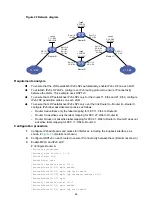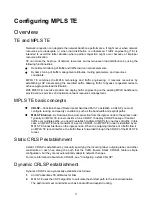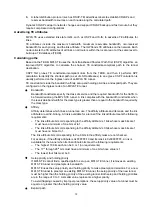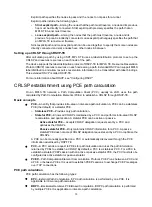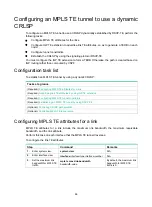
73
Explicit path specifies the nodes to pass and the nodes to not pass for a tunnel.
Explicit paths include the following types:
{
Strict explicit path
—Among the nodes that the path must traverse, a node and its previous
hop must be directly connected. Strict explicit path precisely specifies the path that an
MPLS TE tunnel must traverse.
{
Loose explicit path
—Among the nodes that the path must traverse, a node and its
previous hop can be indirectly connected. Loose explicit path vaguely specifies the path that
an MPLS TE tunnel must traverse.
Strict explicit path and loose explicit path can be used together to specify that some nodes are
directly connected and some nodes have other nodes in between.
Setting up a CRLSP through RSVP-TE
After calculating a path by using CSPF, MPLS TE uses a label distribution protocol to set up the
CRLSP and reserves resources on each node of the path.
The device supports the label distribution protocol of RSVP-TE for MPLS TE. Resource Reservation
Protocol (RSVP) reserves resources on each node along a path. Extended RSVP can support MPLS
label distribution and allow resource reservation information to be transmitted with label bindings.
This extended RSVP is called RSVP-TE.
For more information about RSVP, see "Configuring RSVP."
CRLSP establishment using PCE path calculation
On an MPLS TE network, a Path Computation Client (PCC), usually an LSR, uses the path
calculated by Path Computation Elements (PCEs) to establish a CRLSP through RSVP-TE.
Basic concepts
•
PCE
—An entity that provides intra-area or inter-area path calculation. A PCE can be a stateless
PCE (the default) or a stateful PCE.
{
Stateless PCE
—Provides only path calculation.
{
Stateful PCE
—Knows all CRLSPs maintained by a PCC, and performs intra-area CRLSP
recalculation and optimization. A stateful PCE can be active or passive.
−
Active stateful PCE
—Accepts CRLSP delegation requests sent by a PCC and
optimizes the CRLSPs.
−
Passive stateful PCE
—Only maintains CRLSP information for a PCC. A passive
stateful PCE does not accept CRLSP delegation requests sent by a PCC or optimize the
CRLSPs.
A PCE can be manually specified on a PCC or automatically discovered through the PCE
information advertised by OSPF TE.
•
PCC
—A PCC sends a request to PCEs for path calculation and uses the path information
returned by PCEs to establish a CRLSP. By default, a PCC is a stateless PCC. For a PCC to
establish a stateful PCEP session with an active or passive stateful PCE, the PCC must also be
configured as active stateful or passive stateful.
•
PCEP
—Path Computation Element Communication Protocol. PCEP runs between a PCC and
a PCE, or between PCEs. It is used to establish PCEP sessions to exchange PCEP messages
over TCP connections.
PCE path calculation
PCE path calculation has the following types:
•
EPC
—External Path Computation. EPC path calculation is performed by one PCE. It is
applicable to intra-area path calculation.
•
BRPC
—Backward-Recursive PCE-Based Computation. BRPC path calculation is performed
by multiple PCEs. It is applicable to inter-area path calculation.







